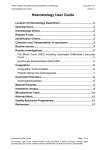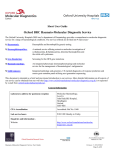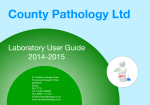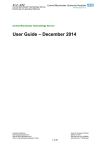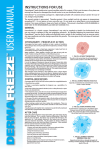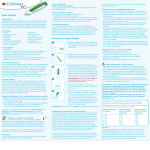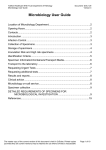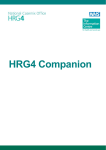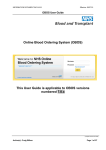Download Pathology Service User Guide Haematology
Transcript
Pathology Service User Guide Haematology Worthing This section of the Pathology Service User Guide includes: • • • • • • • • • • Routine haematology Immunology Haematinic investigations Haemoglobinopathy screening Bone marrow investigations Cytochemistry and other haematological investigations Chromosome analysis Blood transfusion and serology Coagulation Special haematology investigations Routine haematology Full blood count Specimen required: 4ml EDTA (lavender) Reference ranges: Age and sex related; see report form. ESR Specimen required: 4ml EDTA (lavender) One sample is sufficient for FBC and ESR. Raised in pyrexial conditions; inflammatory disease; collagen disease and malignancy. Normal values increase over age fifty and in pregnancy. Reference ranges: Age < fifty years 1-10 mm/hr (M); 1-12 mm/hr (F); age >fifty years 1-20 mm/hr. Blood film Specimen required: 4ml EDTA (lavender) Performed if clinically indicated or to investigate an abnormal FBC. Reticuloctyte count Specimen required: 4ml EDTA (lavender) Increased in haemolysis or after blood loss. May also be used to monitor response to B12 or folate therapy when the reticulocyte count reaches a peak after five days; after iron therapy the peak response is at two weeks. In aplastic anaemia; the reticulocyte count is very low. Reference range: 0.5 – 2.0 %; 20 -100 x 109/L. Infectious mononucleosis (IM) screen Specimen required: 5ml serum SST (gold) Usually positive in infectious mononucleosis. FBC and blood film are also performed and often show characteristic atypical mononuclear cells. Malaria films Specimen required: 4ml EDTA (lavender) Samples should be sent within two hours of a febrile episode. Initial parasite identification and quantitation in the laboratory will be confirmed by the Malaria Reference Laboratory. Haematologists will normally advise on the management of the patient. Please do not send blood films. Immunology Autoimmune profile Specimen required: 5ml serum SST (Gold top) Tests are performed by the immunology department at St Richards Hospital. This combined test will detect auto antibodies to gastric parietal cells; mitochondria; smooth muscle and liver-kidney microsomes. The AIP should be requested for patients with suspected liver autoimmunity; autoimmune gastritis or for the investigation of low serum B12. This will not include an ANA which should be requested separately. ANA should be requested specifically when investigating a suspected connective tissue disorder. Other tests should be requested individually; and it is important to give clear; comprehensive clinical information to allow St Richards to provide interpretive comments and perform additional tests where indicated. Reports are sent directly to the requestor and results are not transcribed on to the laboratory database. Results can be obtained by telephoning 01243 831700. A list of immunology tests performed at Chichester is available to download from the main haematology webpage HLA B27 Specimen required: 4mL EDTA (lavender) Positive in some cases of ankylosing spondylitis (90%). Samples must arrive in the laboratory before midday. Haematinic investigations Normal ranges are age and sex dependant; values given are for an adult male. Vitamin B12 Specimen required: 5ml serum SST (gold) Low levels are found in pernicious anaemia and malabsorbtion; rarely due to dietary deficiency. High levels are found in myeloproliferative states. Testing is not indicated when patients are on B12 therapy. Normal range: 187-883 ng/ml. Serum folate Specimen required: 5ml serum SST (gold) Low levels found in megaloblastic anaemia; malabsorbtion; pregnancy; dietary deficiency; alcoholism and haemolytic anaemia. Testing is not indicated when patients are on folate supplements. Normal range: 3.0 to 20 ug/L Red cell folate Not performed as part of routine anaemia screening – discuss request with haematologist Specimen required: 4ml EDTA (lavender) As for serum folate but less prone to fluctuations due to recent intake of folic acid. Normal range: 120 – 860 ug/L Serum ferritin Specimen required: 5ml serum SST (gold) Level is indicative of total body iron stores. Values are low in iron deficiency and high in haemachromatosis. Results may be unreliable in pregnancy and liver disease and falsely raised in inflammatory disease. Normal range: Male 22 - 275 ng/L. Female 6 – 20 ng/L Haemoglobinopathy screening Antenatal Haemoglobinopathy screens must be accompanied by a fully completed Family Origin Questionnaire (FOQ) Haemoglobin electrophoresis/high performance liquid chromatography Specimen required: 4ml EDTA (lavender) Used to detect abnormal Hb variants in haemoglobinopathies and raised Hb A2/HbF in thalassaemia. Sickle cell screen Specimen required: 4ml EDTA (lavender) Screening test for HbS which causes sickle cell anaemia; useful pre-operative test in patients of Afro-Caribbean origin. HbA2 estimation Specimen required: 4ml EDTA (lavender) May be raised in thalassaemia; iron deficiency may result in false normal levels in thalassaemic patients. Normal range: < 3.5% HbF estimation Specimen required: 4ml EDTA (lavender) Normally high in infants. May be raised in some haemoglobinopathies. Normal level < 1% (adults) G6PD screen Specimen required: 4ml EDTA (lavender) A qualitative test; low levels found in congenital glucose 6 phosphate dehydrogenase deficiency which may cause acute or chronic haemolytic anaemia. Bone marrow investigations Bone marrow aspirate Only by arrangement with the haematologist Essential for the diagnosis of blood dyscrasias; lymphomas and myeloma. May also be useful in the diagnosis of refractory anaemia or malignancy. Bone marrow trephine Only by arrangement with the haematologist Indications as for bone marrow aspirate but gives a better view of bone marrow architecture. Cytochemistry and other haematological investigations Cyclosporin A Specimen required: 4ml EDTA (lavender) Used as an immunosuppressant. Urine haemosiderin Specimen required: 10ml of urine in a white top universal. Iron is excreted in some intravascular haemolytic states and haemachromatosis. Detection of crystals in synovial fluid Specimen required: Synovial fluid in a white top universal. Fluid is examined microscopically under polarised light which enables crystals of urate; present in gout ; or pyrophosphate; present in pseudo-gout to be detected. Not processed out of hours. Beta 2 microglobulin Specimen required: 5ml serum SST (gold) Used to monitor the progress of disease in multiple myeloma; may also be raised in renal tubular dysfunction. Spinal fluid cytology Specimen required: 2 – 3ml of CSF in a white top universal (Haematology patients only). Samples are cytocentrifuged to concentrate any cells and then stained before examination. Used for the detection of leukaemia or lymphoma in the central nervous system. Plasma viscosity Specimen required: 4ml EDTA (lavender) Used to measure viscosity in paraproteinaemia and cryoglobulinaemia. Not performed onsite. Chromosome analysis Samples are sent to reference centres for analysis; sample tubes are available from the laboratory. Routine cytogenetics (karyotyping) Sample required: 5ml lithium heparin (green). Smaller sample volumes will be accepted on infants. Cytogenetics plus DNA analysis (e.g. fragile X) Sample required: 5ml lithium heparin (green) for cytogenetics plus 4ml blood in EDTA (lavender) for DNA analysis. Specific DNA analysis (e.g. CF genotyping) Sample required: three 4ml EDTA (lavender). Bone marrow cytogenetics Discuss request with haematologist. Sample required: special container with transport medium; kept in the lab. Blood transfusion and serology Relevant clinical information must be supplied on the request form; if not the request will be rejected. Sample identification criteria It is essential that patient details on specimen containers are completed AFTER the specimen has been collected – NEVER pre-label specimens Please complete the following minimal information on all specimen containers: • • • • Surname Forename Date of birth Date of collection Specimens for the Blood Transfusion Laboratory must also have: • • • • • Hospital number or NHS number The time of collection, using 24-hour clock e.g. 13:30 Dated, including year i.e. (dd/mm/yy) The signature of the person who collected the sample And completed by the person taking the blood and at the time of collection SAMPLES MUST BE HAND-WRITTEN ADDRESSOGRAPH LABELS OR PRE-PRINTED LABELS ARE NOT PERMITTED ON SAMPLES FOR THE BLOOD TRANSFUSION LABORATORY Specimens for microbiology must also indicate the nature of the specimen 1. Group and Save / Crossmatching Specimen required: 6ml EDTA The sample must not be taken more than 5 days before transfusion is required. (Multi transfused and patients with antibodies require fresher samples – see Transfusion guidelines) To reduce risk to patients that may require a blood transfusion; we insist that our patients unknown to the blood transfusion computer system will require two samples taken on two distinctly separate venepuncture events. There MUST be two separate request forms, one for each. In a clinical emergency we will issue blood and expect a second sample to be sent also. Blood issued will be concentrated red cells in additive solution; usually SAGM and will be available for 24 hours. 2. Blood group Specimen required: 6ml EDTA Used to determine red cell ABO and RhD phenotypes. The person taking the sample must sign the sample bottle. When the test is done for insurance; emigration; occupational or other non-medical reasons a charge will be made to the patient under Category II. 3. Antibody screen Specimen required: 6ml EDTA Blood group antibodies are screened for routinely during grouping and crossmatching. When detected; identification will be carried out in-house if possible or sent to the Blood Transfusion Service. Additional samples may be required for antibody identification. 4. Alloantibody titre Discuss request with haematologist Specimen required: 6ml EDTA Normally performed on pregnant women with known clinically significant antibodies. 5. HLA Antibodies (NHSBT; Tooting/Filton) Specimen required: Four 4.5ml EDTA (lavender) samples. Samples must be taken at the laboratory on Monday to Thursday before 11am. Full clinical reasons for request must be given and samples must be completed to the transfusion requirements. 6. HFE (NHSBT; Tooting/Filton) Specimen required: Four 4.5ml (lavender ) samples Samples must be taken at the laboratory on Monday to Thursday before 11am. Full clinical reasons for request must be given and samples must be completed to the transfusion requirements. 7. Anti-Platelet Antibodies (NHSBT; Filton) Discuss request with laboratory Specimen required: two 5ml SST (gold) and four 4ml EDTA (lavender). Positive in some cases of immune thrombocytopenia. Samples must be taken at the laboratory on Monday to Thursday before 11am. Full clinical reasons for request must be given and samples must be completed to the transfusion requirements. 8. Direct antiglobulin test Specimen required: 6ml EDTA Used to detect antibodies on the red cell surface. Positive in some haemolytic anaemias. 9. Kleihauer test Specimen required: 6ml EDTA Detects the presence of foetal red cells in the maternal circulation in suspected transplacental haemorrhage. 10. Investigation of a blood tranfusion reaction You must immediately inform the Blood Transfusion department on bleep 273 (Worthing Hospital) or 070 ( St.Richard's Hospital) . You should stop the transfusion immediately. A Transfusion Reaction Form will be started and you will be expected to give reasons for the suspected transfusion reaction. The suspect unit(s) should be sent back to the laboratory along with post transfusion samples [6 ml EDTA; 4 ml Lavender top EDTA and Gold top SST (clotted sample); taken from the arm not used for the infusion]; plus a urine sample. Complete a transfusion Request form giving full clinical reasons and all samples must be completed to the transfusion requirements. Coagulation Normal ranges given are for adults; for paediatric ranges please contact the laboratory. Please indicate if the patient is receiving anticoagulants and name them; including direct thrombin inhibitors INR NB: Outpatient INR specimens need to be received at Worthing or Southlands Hospital by 3pm. Specimen required: 3.5ml citrate (blue); tube must be correctly filled. Used to monitor anticoagulant therapy; also used as a screening test of the extrinsic coagulation pathway and is frequently abnormal in liver disease; malabsorbtion; DIC and congenital factor II; VII and X deficiencies. Normal range: 0.8 – 1.2 Activated partial thromboplastin time (APTT) Specimen required: 3.5ml citrate (blue); tube must be correctly filled. Used to monitor heparin therapy; also used as a screening test of the intrinsic coagulation pathway. Abnormal in liver disease and DIC; also in Haemophilia; von Willebrands disease and Christmas disease. Normal range: 0.8 – 1.2 Thrombin time Specimen required: 3.5ml citrate (blue); tube must be correctly filled. Screening test for the final common pathway of the coagulation system. Abnormal in liver disease; DIC; fibrinogen deficiency and during heparin therapy. Normal range: 10 – 17 seconds Fibrinogen Specimen required: 3.5ml citrate (blue); tube must be correctly filled. Abnormal in DIC and obstetric haemorrhage; may be raised in inflammatory conditions. Normal range: 1.5 – 4.0 g / dl D-Dimer – quantitative Specimen required: 3.5ml citrate (blue); tube must be correctly filled. A quantitative assay for the detection of cross linked fibrin degradation products. Elevated levels indicate reactive fibrinolysis and are found in DVT; pulmonary embolus and DIC and may also be seen in inflammation and malignancy. For Suspect Venus Thrombo-Embolism – Negative is < 230 ng/ml Factor assays Please discuss request with haematologist Specimen required: 3.5ml citrate (blue); tube must be correctly filled. Factor VIII – decreased levels are found in haemophilia and von Willebrands disease. Normal range: 50 – 150% Factor IX – decreased levels are found in Christmas disease Normal range: 50- 150 % For other Factor assays please contact the Haematology Laboratory Von Willebrand Factor Please discuss with haematologist Specimen required: 3.5ml citrate (blue); tube must be correctly filled. Used in the diagnosis of haemophilia and von Willebrands disease. Thrombophilia screening Only by arrangement with haematologist Specimens required: four 3.5ml citrate (blue); tubes must be correctly filled; 4ml EDTA (lavender); 5ml serum SST (yellow). Specimens must arrive in laboratory within 1 hour of collection. Investigation of selected patients with venous or arterial thrombosis to exclude hereditary deficiencies of coagulation inhibitors. Anti phospholipid screening may also be performed as part of a thrombophilia screen or may be requested separately in cases of recurrent miscarriage or lupus. Anti factor Xa assay Low molecular weight heparin level (anti factor Xa assay): please discuss with haematologist. Specimen required: 3.5ml citrate (blue); tube must be correctly filled. Used to monitor low molecular weight heparin therapy. Results are dependent on the LMWH preparation used and whether treatment is therapeutic or prophylactic. Special haematology investigations Most of these investigations require an out-patient consultation with the haematologist and attendance at the hospital. A referral letter is preferred. 1. Investigation of a suspected bleeding diathesis A history is taken and the following investigations performed: FBC; BT; INR; APTT; TT. Further investigation will follow depending on the result. 2. Investigation of thrombophilia A history is taken and the following investigations performed: FBC; ESR; INR; APTT; TT; Fibrinogen. If indicated; AT III; lupus anticoagulant; anticardiolipin antibodies; Protein C; Protein S; APCR; Factor VIII. 3. Investigation of an haemolytic anaemia This requires a hospital referral to the consultant haematologist. The choice of investigations will depend on the type of haemolytic anaemia suspected. 4. Investigation of unexplained anaemia Causes of unexplained anaemia are so numerous that referral to the haematologist is essential. Investigations will depend on the history and examination 5. Anticoagulant control for venous and arterial thromboembolism Referral from the wards should be made using the pink forms. Referral from general practice should be via a letter or telephone call to the haematologist. Anticoagulant clinics are held at set times in Worthing and Southlands Hospitals and also Littlehampton hospital. Clinicians should indicate how long anticoagulant therapy is to be continued. 6. The diagnosis and management of malignant haematological disorders The department has an extensive clinical haematology practice; looking after all forms of malignant haematological disorders e.g. leukaemia; lymphoma and myeloma. Referral should be direct to a consultant haematologist. Patients may be referred on to specialist centres following diagnosis and initial management; e.g. for bone marrow transplantation.
















